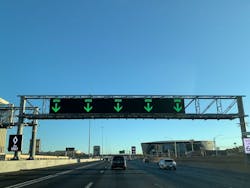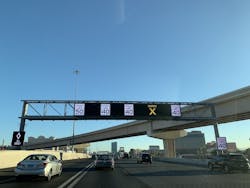Intelligently managing traffic with advanced dynamic message signs
One of the most dynamic cities in the world, Las Vegas, Nevada, requires a traffic management system to match—one that will mitigate congestion, ensure travel-time reliability, improve safety, and increase overall efficiency for millions of residents and visitors.
It is no easy undertaking given Las Vegas’ 24/7 lifestyle, sprawling neighborhood development, and diverse population. But with innovative thinking, robust partnerships, and advanced technology—like its new Active Traffic Management System—Southern Nevada has risen to the challenge and positioned itself as a leader in cutting-edge traffic management.
The Regional Transportation Commission of Southern Nevada (RTC)—which oversees public transportation, traffic management, and transportation planning for the Las Vegas Valley—has achieved this level of excellence through the addition of intelligent transportation systems (ITS) to its arsenal of traffic management tools. ITS includes state-of-the-art wireless, electronic, and automated technologies that advance transportation safety and mobility and can include traffic-control measures such as ramp meters and traffic signal coordination.
ITS options are becoming more attractive when compared to the traditional method of increasing capacity and managing mobility, which is paving new roadway. With space at a premium and a mile of new roadway costing approximately $6 million to construct, ITS options are more cost effective, faster to implement, and have been shown to improve safety and mobility. Technology is truly becoming the new asphalt, but it takes collaboration among partners, a willingness to test and try new tools, and determining how effective they are in achieving project goals.
Collaboration is key
Leveraging ITS to its full potential necessitates broad-based partnerships. The RTC’s success in traffic management and use of ITS is due in part to its successful and long-standing partnerships, including with the state, local municipalities, and various other organizations. One such invaluable partnership is with the Nevada Department of Transportation (NDOT). The two agencies work hand-in hand to plan for the future of transportation in Southern Nevada and often share responsibilities on traffic management initiatives. One example is the freeway ramp meter system, a partnership between the agencies that falls under the authority of the RTC’s Freeway and Arterial System of Transportation (FAST) Department.
While the RTC and NDOT have worked together at FAST and on transportation projects for decades, one shining example of their successful partnership is the implementation of advanced ITS within Project Neon, the largest public works project in Nevada history. Completed in 2019 and overseen by NDOT, Project Neon widened 3.7 miles of I-15 between Sahara Avenue and downtown Las Vegas. The stretch of highway, which is the busiest in the state, sees nearly 300,000 vehicles daily and 25,000 lane changes per hour.
With the ultimate goal of improving safety while reducing congestion and travel delays, Project Neon presented the perfect opportunity to incorporate ITS. A first in the state of Nevada, NDOT installed a series of overhead active traffic management (ATM) system signs along I-15 and U.S. 95. The ATM system includes 42 full-color, high-resolution signs that resemble scoreboards, with the largest reaching 13 ft high by 77 ft wide. While NDOT installed and owns the equipment, the RTC oversees the ongoing operation under the authority of FAST.
The Project Neon ATM system had been planned for years, but its activation occurred at a time when traffic patterns changed dramatically and unexpectedly. The full system went online around March 23, 2020, just days after widespread government shutdowns occurred due to the COVID-19 pandemic. With people staying home and traffic volumes down on average 30% or more, engineers were able to test the system with much less impact to the traveling public.
Utilizing advanced technology
As people gradually returned to the roads, the new ATM system was up and running. Although Southern Nevada has been home to more traditional dynamic messaging signs for years, Project Neon’s ATM signs are much more sophisticated, offering next-generation, real-time driver information. These ATM signs provide the ability to dynamically manage traffic congestion based on prevailing and predicted traffic conditions using data, such as average speed for individual travel lanes, which is collected via loop detectors throughout the corridor. Using this data, the ATM signs provide drivers with information on speed, lane, and road status. Additionally, footage from closed circuit TV cameras throughout the corridor provides another layer of information allowing system operators to identify, react to, and confirm incidents and congestion.
The data is presented overhead using intuitive navigational symbols that make it easy for drivers to recognize and react swiftly to changing conditions. The symbols appear above each lane, indicating if it is open (shown with a green arrow); is open but will require merging (shown with a yellow “X”); or closed due to an upcoming incident (shown with a red “X”). In addition to the symbols, overhead messaging warns motorists of backups and collisions ahead.
The ATM system includes two other important features: first, variable speed limit signs can allow for the speed limit to be modified, allowing for ‘speed harmonization’ which provides advance notice of congestion due to backups and can help facilitate the flow of traffic; second, available dynamic HOV lane signs allow for HOV lanes to be switched to full-use lanes when needed, easing congestion during a crash. Since the ATM system went live in March 2020, FAST has manually activated the “HOV Open to All” feature 149 times to accommodate traffic congestion resulting from crashes or other incidents to enhance the flow of traffic and reduce bottlenecking that could lead to secondary incidents.
The future looks bright
Altogether, these features empower motorists with the opportunity to react well before incidents, thereby cutting down on commute times and greatly reducing the potential for secondary crashes. In fact, data has shown that states that have invested in ATM systems have experienced a significant reduction in primary and secondary crashes, especially on weekends. This is attributable to ‘non-commuter’ drivers who may not be familiar with the area. This is especially helpful in Las Vegas where large numbers of tourists drive along I-15 each weekend.
The ATM signs have been so successful that more are planned for the Las Vegas Valley. Thanks to a $6 million grant from the U.S. Department of Transportation, funding is on the way. The Advanced Transportation and Congestion Management Technologies Deployment (ATCMTD) grant
will allow the RTC to expand its current safety initiative along a 5-mile corridor of U.S. 95 that carries approximately 230,000 vehicles daily and was the location of 599 crashes in 2020. In addition to 10 more ATM signs being planned for future installation along the I-15 stadium corridor between Russell Road and the 215 Beltway, the program will allow for other ITS enhancements, including wrong-way driver sensors and occupancy detection sensors in HOV lanes.
The ITS and ATM system capabilities can clearly enhance mobility and safety for the millions of drivers on the road every year. As technology continues to advance, we will have the opportunity to leverage innovation even more to build on the successes we have already seen and further improve our transportation systems, thereby strengthening our communities by reducing congestion, supporting commerce, improving air quality, and ultimately saving lives. Given its proven capabilities and potential, advanced ITS will continue to offer creative high-tech solutions that will be the foundation of the RTC’s collaborative traffic management system in 2021 and beyond.

